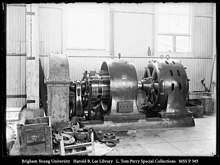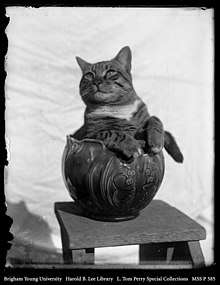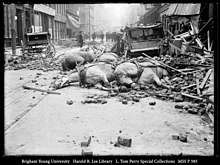Edith Irvine
Lizzie Edith Irvine (7 January 1884 – 1949) was an American photographer who documented the 1906 San Francisco earthquake.
Edith Irvine | |
|---|---|
.jpg) | |
| Born | January 7, 1884 Calaveras County, California |
| Died | August 14, 1949 (aged 65) Calaveras County, California |
| Nationality | American |
| Known for | Photography |




Early life
Irvine was born in Sheep Ranch, Calaveras County, California to Thomas Hanna Irvine and Mary Irene (Hills) Irvine. Her father was a gold miner.[1]
Edith’s grandfather, William Irvine, was the youngest in a family of nine children, and was born in Ireland. In 1846 William immigrated to New York with his older brother, James. Both William and James travelled to California to try to find gold in the 1849 gold rush. After successfully mining gold, James joined the upper class in southern California and owned the 110,000-acre (450 km2) Irvine Ranch in Orange County. He also had a produce and delivery business in San Francisco, and owned a home in San Francisco at Folsom and Eleventh streets.[1]
When James Irvine died on 15 March 1886, he directed in his will that over US$100,000 should be provided his wife, brothers, sisters, and other relatives through the liquidation of many of his properties. Substantial land gifts, not to exceed the value of $5,000 were also to be given family members from his holdings in southern California. Wilma ("Billy") Plunkett, Photoarchivist at the Lee Library in 1988, indicates in her master’s project on Irvine, that the “family fortunes increased due to acquisitions of mines and other real estate,” and that the Irvine family became part of the “upper social strata of the area.” Irvine apparently often visited with family members in San Francisco and southern California.[2]
Irvine and her brother Robert lived together most of their lives as she never married and he didn’t marry until he was 60 years old. They continued to live together in the family home now in Mokelumne Hill, California.
Photography
By her early teens Irvine had created a darkroom in a rear corner of the house in Mokelumne Hill, or Moke Hill as the natives call it. At 14, in 1898, she was already photographing the extensive Electra Power Project – an early hydroelectric power project in California. This project, near her home on the Mokelumne River, California, was completed in 1902. Family tradition says that she was hired as a photographer for this project by Standard Electric of California, the predecessor of Pacific Gas & Electric Company, but no records have been found to substantiate that. Her work at that young age is impressive in documenting a monumental civil engineering project.
Her next great photographic venture, and certainly the epitome of her brief photography career, came at the age of 22, documenting the 1906 San Francisco earthquake. Her photographs draw the viewer into the full range of the earthquake experiences, from devastation to even humor. In 1910 she considered herself a professional photographer as noted on the census, but for reasons unknown, by 1920 her occupation was school teacher.
Anecdotal stories that Plunkett gathered for her master’s project[2] indicate that Edith had long red hair and that she loved to ride her horses and drive her Model T Ford. In her later years no one outside of the family seemed to be aware of her photographs. One of her former students characterized her as fair, but strict, and a good teacher.
Health and later years
Edith’s life was difficult both physically and emotionally. She apparently suffered from severe joint pains of unknown origin, which were treated by her doctor with painkillers. Later she lapsed into alcoholism – all of which caused severe mental deterioration as well as the expected physical deterioration. In addition she began to lose her hearing at an early age, until by 45 years old, she had become severely hearing impaired.
She never recovered from the medical and emotional problems that she suffered from in her later years. Not long after her brother, Bob, was granted legal guardianship for her on 8 June 1949, she died at age of 65. It was with the donation of her small collection of photographs to the Brigham Young University Library in 1988 by her nephew, Jim Irvine, Bob’s son, that her photographic talents became known outside of her circle of family and friends.
Subject matter
Her black and white photograph Dead Horses attests to her photographic vision. At least four dead horses which were pulling carriages lie in their traces among broken carriages and brick rubble from the San Francisco earthquake of 1906. The gelatin dry plate negative, 12.7 cm × 17.78 cm (5.00 in × 7.00 in) exists in the L. Tom Perry Special Collections at Brigham Young University's Harold B. Lee Library. The library holds 293 images in the Irvine Collection.[3] They range in subject matter from landscapes (such as the Bridalveil Fall) and bridges, to everyday life, family portraits, infant deaths and Mokelume Hill townscapes. Her oeuvre includes much from a redwood forest to city buildings, as well as the earthquake and its effect on architecture, street scapes, fires and prevailing activities amidst the destruction.[3]
In 2005, five undiscovered photographs by Edith Irvine were found within a collection in southern California. They were all of San Francisco's 1906 earthquake and fire. Edith had visited the Irvine Ranch more than once during her lifetime and possibly gave them to the Irvine family. Subsequently, those photos plus the entire collection of 1906 earthquake photographs from James Irvine were published in a book: Two Weeks in San Francisco by Douglas Westfall and Henry C. Koerper, (The Paragon Agency, Publishers - 2006) and released in the city of San Francisco on April 18, 2006. Up to that time, a vast majority of Irvine's photographs had never been published.
References
- "Edith Irvine Collection: Biography". lib.byu.edu. Brigham Young University. Retrieved 31 May 2017.
- Plunkett, Wilma Marie (1989). Edith Irvine: Her Life and Photography (Thesis). Brigham Young University. Retrieved May 31, 2017.
- Edith Irvine Collection : Browse
External links

- Edith Irvine at Find a Grave
- The Edith Irvine Collection and its History Digital Collections, Historical Photographs, Harold B. Lee Library, Brigham Young University.